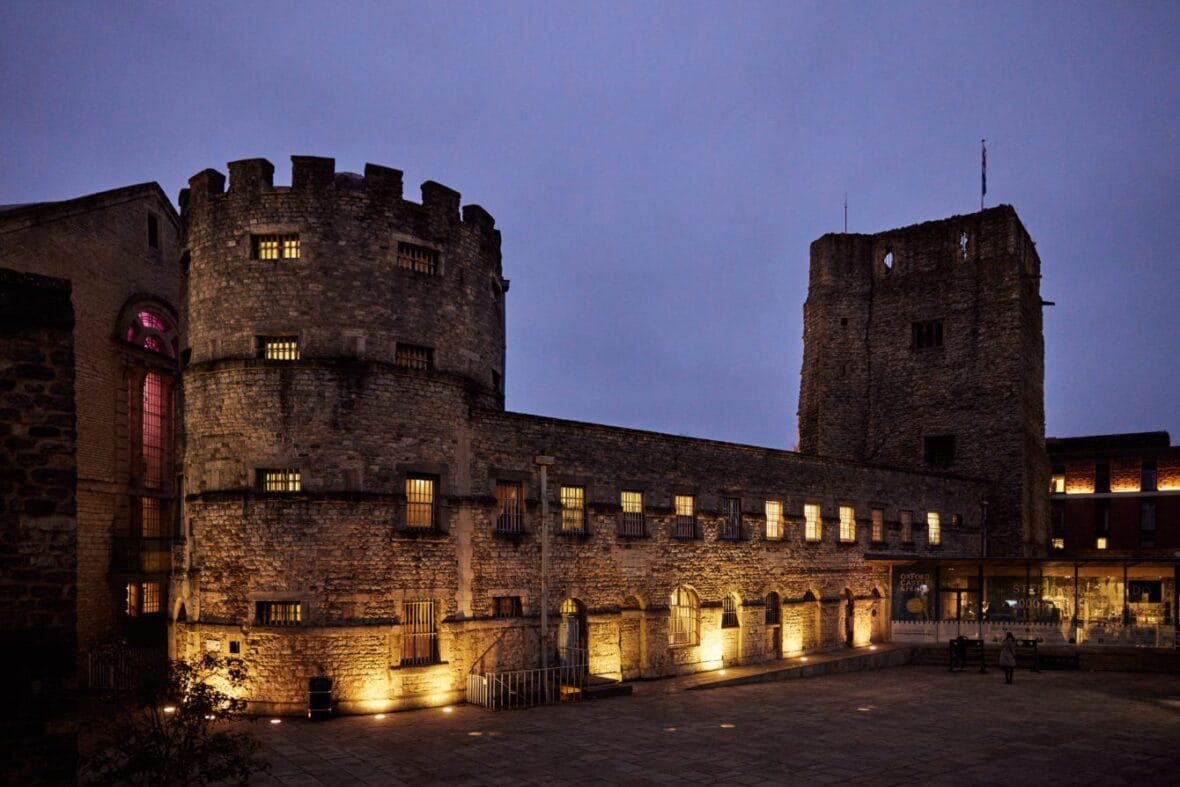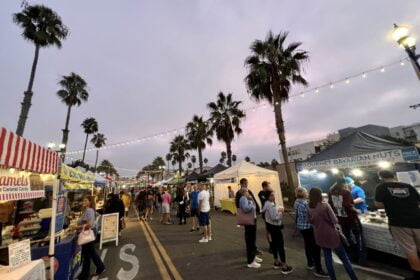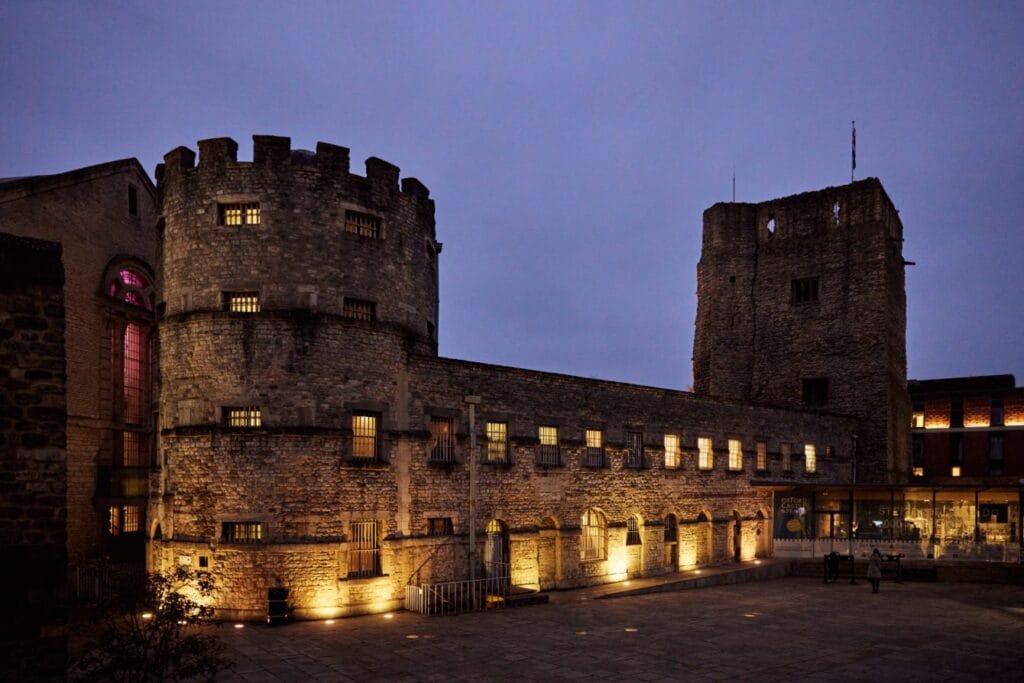
Oxford Castle and Prison at night from the outside. Inside, it looks even more imposing. (Peg Fong photo for Vacay Network)
Nothing transports you back in time and confronts you with the consequences of past misdeeds like being put into stocks in a medieval castle.
True, I’ve done some not great (bad) things in my life. I had arrived late, almost at closing time at Oxford Castle and Prison, and missed the last official tour.
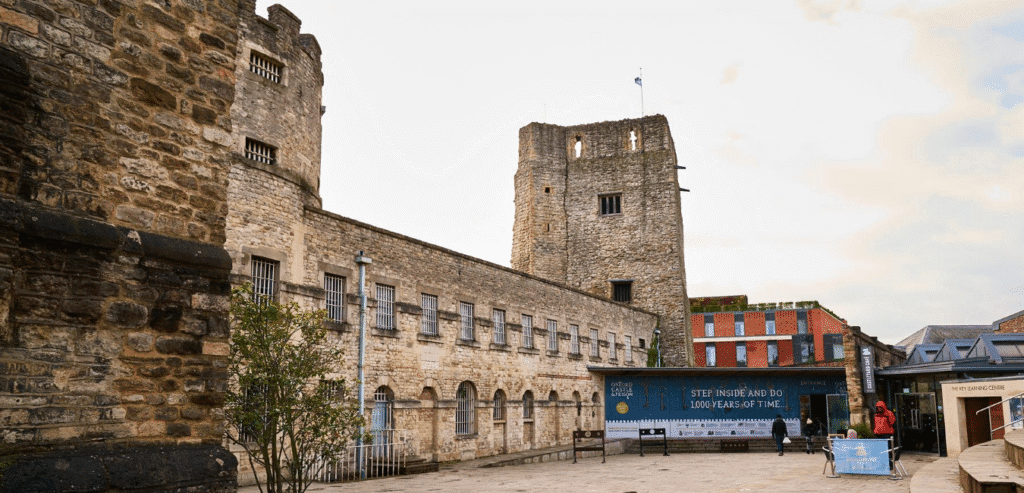
Oxford Castle and Prison was closed in 1996 and reverted back to Oxfordshire County Council which redeveloped it into a restaurant and tourist attraction. (Peg Fong photo for Vacay Network).
But do I deserve to be put in stocks, the form of public punishment and humiliation where offenders were paraded out in village squares so they could be exposed to ridicule and verbal abuse?
Think of it as being on social media, but back before there was digital, and basic prisoners’ rights. The wooden device has a bigger hole where your head sticks through and smaller ones for wrists and ankles. Being stuck in the stocks does give you lots of time to think.
The first thing you have time to contemplate is how it’s not the grandeur or the history in Oxford and Oxford Castle and Prison that you’ll notice. It’s the quiet. The kind that settles between centuries-old buildings and cobbled lanes and inside castle walls where people have been deliberately locked up. Those were the kind of thoughts that went through my mind when I was doing time in the stocks. My other thought was this: I was a village idiot. Trying out the stocks by getting into them was simple enough. Head, wrists go into the holes. Getting out, however, demanded far more than I’d bargained for.
Students and prisoners have come and gone here for almost a millennium. Oxford is older than Canada itself by multiple centuries. Teaching began at Oxford as early as 1096, making the University of Oxford the oldest English-speaking university in the world. Oxford Castle, which became Oxford Prison, was built in 1071. Oxford Prison was closed in 1996 after more than 300 years of incarceration on the site. It was reopened as a hotel and heritage attraction in 2006.
As I was wondering how I had gotten myself into this fine mess, another date came to mind, Valentine’s Day. I had been allowed to wander on my own because the staff was setting up around the prison for a special dine-in event for Valentine’s Day that evening I was there.
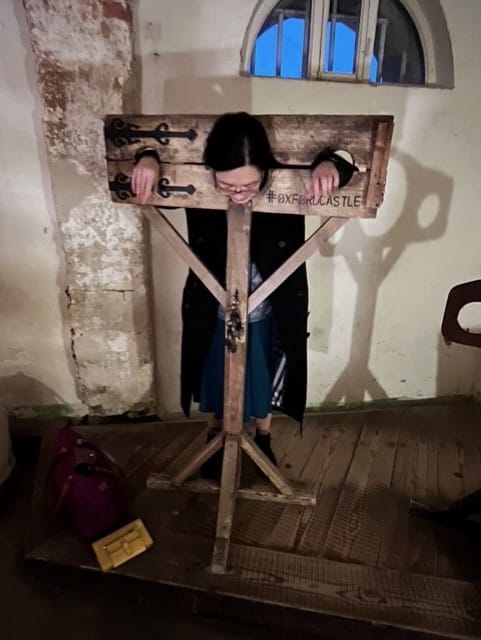
Come on! I was only a little late for the last tour. (Peg Fong photo for Vacay Network).
Diners could sign up for romantic meals in the prison cells or even in the 900-year-old Norman crypt. I was found, had my photo taken, and released for good behaviour.
Oxford prison offers visitors a glimpse into the darker chapters of Oxford’s past. A short 20-minute walk away, the Bodleian Library offers a more enlightened history. The principal University library, the Bod, as it’s known to frequent users, has been a quiet monument to scholarship with its vaulted reading rooms and medieval stacks. Thinkers from monarchs and Nobel Laureates to Canadian Rhodes Scholars and future Canadian political leaders, including current PM Mark Carney.
Carney, elected as prime minister in May of 2025, played hockey as a goalie for the Oxford Blues team and received his master’s and doctorate degrees at Oxford. His doctoral thesis, completed in 1995 as part of his DPhil in Economics at Nuffield College, Oxford, on The Dynamic Advantage of Competition, argued that an increase in domestic competition, even in countries with open markets, was associated with improved national competitiveness. His perspective that a cooperative global framework was needed in the world today was forged during his time at Oxford studying under economists like Meg Meyer and Nobel Laureate Jim Mirrlees.
Throughout his career, first working in private banking at Goldman Sachs during the 1997 Asian currency collapse, then as governor at the Bank of Canada during the 2008 global financial crisis, and at the Bank of England as the bank’s first non-British governor in its 300-year history, Carney has advocated for coordinated global action.
“We simply cannot take the capitalist system, which produces such plenty and so many solutions, for granted,” Carney said in a 2014 speech when he was the governor of the Bank of England. “Prosperity requires not just investment in economic capital, but investment in social capital.”
Inside the Bodleian Old Library, students have three spaces to work: a Lower Reading Room, an Upper Reading Room, and the massive floor space of Duke Humfrey’s Reading Room with its vaulted ceiling and deep history. Scholars have studied in that space since 1488.

The Bodleian Libraries is one of the oldest libraries in Europe and remains a working library to this day. (Peg Fong photo for Vacay Network)
Outside the library and at various colleges on campus, visitors, some dressed as characters from the Harry Potter movies with their wizardry robes, roamed the streets. Oxford, the university and the surrounding county of Oxfordshire, remain one of the most famous destinations in the world for movie and TV shoots.
The Harry Potter series was shot at the Bodleian Library and Christ Church College. The 2023 Wonka film starring Timothee Chalamet used the college facades and Hertford Bridge, more charmingly known as the Bridge of Sighs, as its setting for chocolate-themed locations. Saltburn, another 2023 film, used an Oxford pub as one of the hangouts where the characters drank and confided their family secrets. More recently, the 2025 Netflix flick My Oxford Year, based on the book by novelist Jill Whelan, was filmed at Magdalen College and Radcliffe Square.

From Harry Potter to Saltburn to Wonka, Oxford has been the backdrop and often a leading character in movies, attracting visitors from all over the world. (Peg Fong photo for Vacay Network).
The city’s iconic Randolph Hotel is also used frequently for film and TV locations, with its central location right in the heart of Oxford on Beaumont Street opposite the Ashmolean Museum. The Alice brasserie, named after former Oxford professor Lewis Carroll’s famous literary heroine, has fine dining, and the hotel’s lounge is named the Morse Bar as a tribute to the TV detective Inspector Morse. The author of the series, Colin Dexter, wrote at the hotel and was a regular patron in the wood-paneled, cozy bar.
In Oxford and Oxfordshire, the places here stay with you, like a favourite scene you can watch again and again. From its enchanting streets to the majestic vaulted ceilings of libraries surrounded by books and history, this is a place that ignites imagination and inspires creative visions captured on screens big and small.
MORE ABOUT OXFORD AND OXFORDSHIRE
Visit Britain here and Experience Oxfordshire here
Getting There: British Airways flies direct to London from Vancouver, Toronto and Montreal. BA flies 7 times a week from Vancouver. It was my first time ever flying Business class and it was worth it. I wasn’t sure what to expect but Business class was billed as having your favourite armchair, bed, dining table, office all in one. I would reverse that. For the direct 9 hour 25 minute flight, from YVR, I treated the journey as an easy day at work. I got to the office, worked for a few hours, had a meal, worked some more, relaxed with a movie, and then went to sleep. When I woke up, I was at Heathrow.
Where to Stay: One Aldwych in London is a luxury hotel located near theatres and cultural landmarks in Covent Garden with refurbished, sophisticated rooms and suites with dressing rooms and sumptuous bathtubs. The Nag’s Head in Great Missenden is an ivy-clad coaching inn located in the Chilterns for those eager to step back in time but still needing Wifi. It’s a great base for exploring the Roald Dahl Museum and Missenden Abbey. In Oxford, The Randolph is a historic landmark hotel opposite the Ashmolean Museum. It’s rich in Victorian Gothic architecture and infused in every corner with literary and collegiate-inspired interiors with nods to Lewis Carroll and the Alice in Wonderland-themed restaurant, and the famous Morse Bar from Inspector Morse. It’s conveniently located just steps from shops and cultural and academic highlights.

